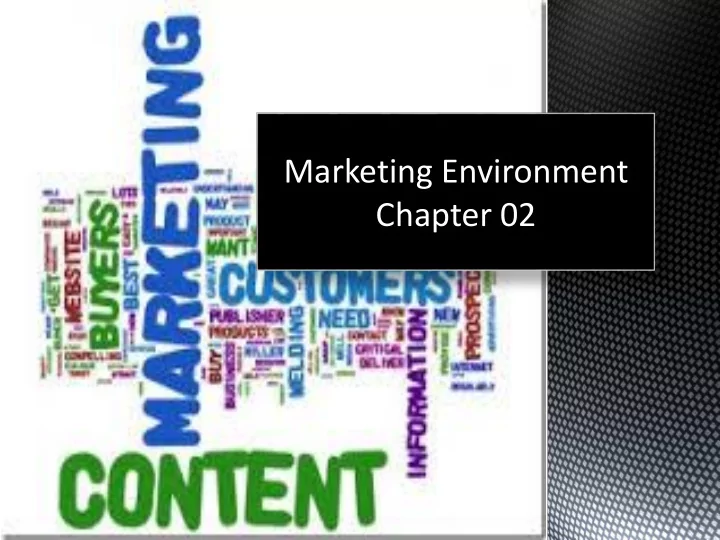

Marketing Environment Chapter 02
Mark rketi eting ng Environ onme ment nt A company’s marketing environment consists of the actors (people) and forces outside marketing that affect marketing management’s ability to build and maintain successful relationships with target customers. (Philip Kotler -12 th Edition)
Marketing Environmental Framework Marketing environment has 3 basic layers (levels) as shown below Forces Actors Macro Environment PESTEL P olitical Micro Environment factors Competitors Publics L egal Internal Customers Environment E conomic Suppliers Intermediaries E nvironmental S ocio-cultural T echnological To be successful, a marketer should monitor changes happening in the entire marketing environment
Marketing Mix Marketing Mix is the set of controllable, tactical marketing tools that the firm blends to produce the response it wants in the target market. (Philip Kotler – 12th edition) Product Marketers need to offer the right product at right price in right Marketing Promotion Price Mix/Tools channels (place) with right communication (promotion) Place
Product There are 4 tools P roduct P rice P lace Marketing P romotion Promotion Price Mix/Tools They are also known as 4P’s Place
Extended Marketing Mix Applicable for Services Product Physical Price Evidence Marketing mix Process Place People Promotion
EXTENDED MARKETING MIX ELEMENTS
Seven P’s might be better described as the seven C’s: Producers View (7P’s) Customers View (7C’s) • Product • Customer Value • Price • Cost • Place • Convenience • Promotion • Communication • People • Consideration • Process • Co-ordination • Physical Evidence • Confirmation
Product
DEFINITION OF A PRODUCT Anything that can be offered to a market for attention, acquisition, use or consumption that might satisfy a want or need (Philip Kotler – 12 th Edition)
Products Consumer Products • Convenience products • Shopping products • Specialty products • Unsought products Industrial Products
Convenience Products Also known as FMCG These are relatively inexpensive and frequently purchased consumer products. The consumer puts little effort into the purchasing decision and convenience takes priority over brand loyalty.
Shopping Products These are less frequently purchased consumer products that customers compare carefully on suitability, quality, price and style. This sort of purchase is usually only made after a good deal of advance planning and shopping around.
Specialty Products These are consumer products with unique characteristics or brand identification for which a significant group of buyers are willing to make a special purchase effort.
Unsought Products . These are consumer products that the consumer either does not know about or knows about but does not normally think of buying. Examples are life insurance, magazine subscriptions, encyclopedias, donations for charity and blood donations.
Product - Components – Variety – Design – Quality – Features – Brand name – Packaging
Levels of Product Core Benefit - the fundamental need or want that consumers satisfy by consuming the product or service Generic Product - a version of the product containing only those attributes or characteristics absolutely necessary for it to function Expected Product - the set of attributes or characteristics that buyers normally expect and agree to when they purchase a product Potential Augmented Product Augmented inclusion of additional features, benefits, attributes or Expected related services that serve to differentiate the product from Generic its competitors Potential Product Core all the augmentations and transformations a product might undergo in the future
2. Pricing
WHAT IS PRICE? Price is the amount of money charged for a product or service, or the sum of all the values that consumers exchange for the benefit of having or using the product or service. (Philip Kotler - 12 th edition)
• Prices of products are mostly printed on the product/package it self • Prices for services are referred in different terms, such as: Rent, Fees, Premium, Tax, Salary, etc.
Price - components List price Discounts Payment terms
Customers are very sensitive towards price ‘Price’ brings revenue (cash) to companies Price is a reason for bargaining It is a weapon to compete Customers often equate with quality
PRICING STRATEGIES Cost Based/Internal oriented pricing Competitor-Based pricing Demand/Market Based pricing
DEMAND/MARKET BASED PRICING • Price skimming • Penetration pricing • Psychological pricing • Promotional pricing • Value-based pricing
The End Thank You
Recommend
More recommend